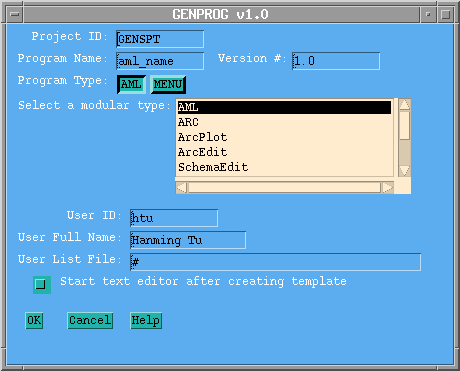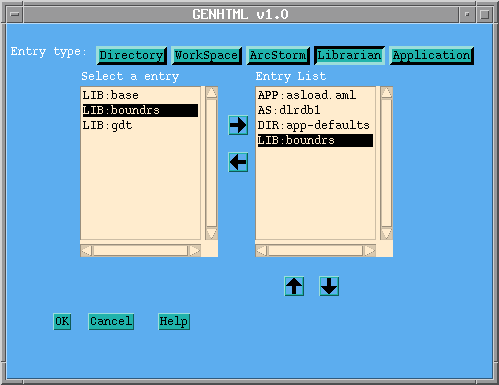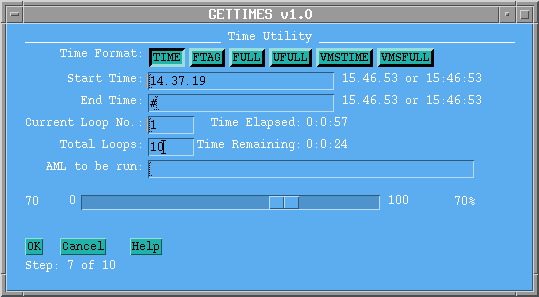 The sub-menu of GENPROG can also be called from the command mode by issuing
The sub-menu of GENPROG can also be called from the command mode by issuing
The AutoAML is a collection of AMLs written in ArcInfo version 7.0.3 and IBM AIX 3.2.5 and later tested in ArcInfo 7.0.4 and AIX 4.1.4. It can be run in two modes: menu driven or ArcInfo commands. AutoAML can
This paper introduces the issues that AutoAML intends to address, then extends to discuss how to solve the problems related to application development and document management in the subsequent sections. Section 2 discusses approaches used in application development and how AutoAML can help in standardizing AML and menu formats. Section 3 explores document management and presents choices for publishing databases and documents. Section 4 introduces tools for monitoring program performance. Section 5 discusses the limitations in AutoAML and improvements needed in the future.
 Two kinds of files are used in ArcInfo application development: one is
AML file; the other is menu file. That is the two files that AutoAML ought
to standardize. The sub-program genprog.aml can be used
to generate standardized templates. All the sub-programs in AutoAML can be
invoked from the menu or command mode. The main menu can be started in
ARC prompt by typing
Two kinds of files are used in ArcInfo application development: one is
AML file; the other is menu file. That is the two files that AutoAML ought
to standardize. The sub-program genprog.aml can be used
to generate standardized templates. All the sub-programs in AutoAML can be
invoked from the menu or command mode. The main menu can be started in
ARC prompt by typing
autoamlThen the genprog menu can be called from the driven menu.
 The sub-menu of GENPROG can also be called from the command mode by issuing
The sub-menu of GENPROG can also be called from the command mode by issuing
autoaml genprogFrom the menu you can specify project ID, program name, version number, program type, and where you want to place the program. The target location can be specified from a list of modular types. User name and full name are obtained from passwd file on the system. You can change the user name and specify a file containing full names of users. Then the program will get user full name from the file you specified.
The usages of autoaml.aml and genprog.aml are:
Usage: AUTOAML {routine|sub-program}
Usage: GENPROG {type} {project_ID} {user_id}
{usr_list_file} {Start_VI:n|y}
Note: {type:cur|aml|arc|ae|ap|grid|tin|real_dir} for AML
{type:7|6|5|4|3|2|1|app} for MENU
Please click AML and
Menu for examples of AML template and menu template generated by
genprog.aml .
There are two ways used in version management: patching and rolling. Patching approach is commonly used in COBOL for developing applications on mainframe. Once a new request or modification is placed, new codes will be generated to fullfil the task and will overwrite the existing codes only during runtime. The advantage of patching is using less disk space (only duplicate codes that are affected). The first drawback is that many paths need to be to be included in menu and aml paths. It is very easy exceeding the limit of 30 paths in aml and menu path. It is slower than rolling since many directories need to be searched. It requires to modify the main program which sets the paths if any new version, release, modification, or patching number is generated.
Rolling approach requires to copy all the existing programs into a new version or release location, then either add new codes or modify existing programs and need significant amount of disk space if the application is quite large. These approach has many advantages. First, it does not need to change path settings in the main program. Invoking a new version can be done by simply point the global variable to the new version or modification number. Secondly, it runs faster since less paths need to be searhced. If the paths are referenced in the main program as the followings:
&amlpath $VPATH/amls &menupath $VPATH/menu &atool $VPATH/atoolSetting VPATH = /apps/v2.1 will enable version 2.1 to be executed.
The following table shows the file structure difference between the approaches.
Patching Rolling -------------- ----------------- $APATH/amls/v2.0.0.0/... /apps/v2.1/amls/... $APATH/amls/v1.1.2.0/... /apps/v2.1/menu/... $APATH/amls/v1.1.1.2/... /apps/v2.1/atool/... $APATH/amls/v1.1.1.1/... /apps/v1.3/amls/... $APATH/menu/v1.1/... /apps/v1.3/menu/... $APATH/menu/v1.0/... /apps/v1.3/atool...Generally patching approach is better in handling the situation where many modification and patch updates are requested for the applications. Rolling approach is better in managing applications which only major release updates are needed. Back to TOC
 The term document used here is very broad. It includes
program files, meta files, INFO files, coverages, directories,
and databases. They can be grouped into three categories:
applications, databases, and directories.
AutoAML can be used to create HTML documents and links them into a
framed page . The sub-program -
genhtmll.aml can be invoked through
autoaml AML or menu, or it can be initiated in ArcInfo command
line. The graph on the right shows the main menu of genhtml
. From the menu you can select entry type, then select entries from
left window to add to the list on the right. Click the OK button, then
it will generate HTML pages based on the categories. Menus will be added
in the future so that users can customize logo, color, font, and layout.
The term document used here is very broad. It includes
program files, meta files, INFO files, coverages, directories,
and databases. They can be grouped into three categories:
applications, databases, and directories.
AutoAML can be used to create HTML documents and links them into a
framed page . The sub-program -
genhtmll.aml can be invoked through
autoaml AML or menu, or it can be initiated in ArcInfo command
line. The graph on the right shows the main menu of genhtml
. From the menu you can select entry type, then select entries from
left window to add to the list on the right. Click the OK button, then
it will generate HTML pages based on the categories. Menus will be added
in the future so that users can customize logo, color, font, and layout.
More detailed reports can be generated if the variable of reporting in detail is checked.
There are couple of challenges encountered in creating HTML documents. First one is directory recursion. The second is inserting HTML tags. The third is getting file types. A loop technique is desgned to accomplish recursion while proerly inserting corresponding HTML tags.
 The gettimes.aml is a very nice tool to be used for
reporting the progress of your programs. It reports the elapsed time,
remaining time, and accumulated descrepancy time caused by
gettimes.aml itself. It can be invoked from AutoAML on the command
line or from AutoAML's menu. The usage of gettimes.aml is
The gettimes.aml is a very nice tool to be used for
reporting the progress of your programs. It reports the elapsed time,
remaining time, and accumulated descrepancy time caused by
gettimes.aml itself. It can be invoked from AutoAML on the command
line or from AutoAML's menu. The usage of gettimes.aml is
Usage: GETTINES < TIME | FULL | UFULL | FTAG | VMSTIME | VMSFULL >
{StartTime} {EndTime} {CurrentLoopNo} {TotalLoops}
{verbose:y|n}
You can type in an expendable command in the field "AML to be run," then
watch it progressing. The menu displays times, steps and percentage
accomplished.
If you include gettimes.aml in the loop of your program,
you will get the report like the following:
5 of 66: Time elapsed 1:05:12 (h:m:s) Time remaining 2 days 8:23:45 (h:m:s) Accumulated discrepancy time by gettimes is 1 seconds.
In order to improve the performance of some sub-programs, C language may need to be introduced. In publishing library database, it is desirable to present libraries in tiled structure, so image map needs to be introduced in HTML document. In documenting application, a flow diagram may be more desirable.
Any comment, or suggestion is greatly appreciated.
Back to TOC